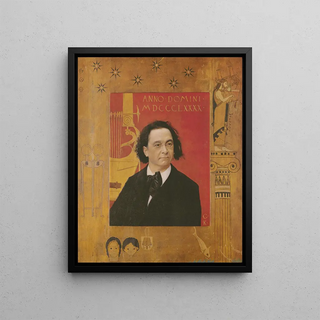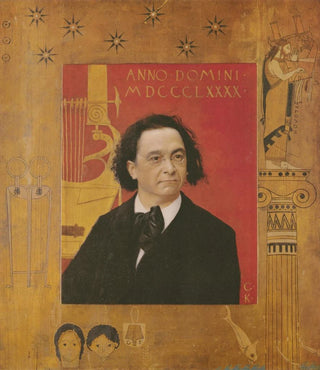Art print | Portrait of Josef Pembaur - Gustav Klimt


View from behind

Frame (optional)
The "Portrait of Josef Pembaur" by Gustav Klimt is an iconic artwork that embodies the very essence of the Viennese Secession movement. Created in 1912, this canvas stands out for its ability to transcend a simple portrait, offering an immersion into the intimate universe of its subject. Josef Pembaur, a man of culture and art, is captured in a posture that evokes both reflection and psychological depth. Klimt, with his inimitable style, manages to create a visual dialogue between the subject and the viewer, plunging this last into an atmosphere that is both mysterious and fascinating.
Style and uniqueness of the work
Klimt's style in this portrait is characterized by a bold use of motifs and colors. Unlike a realistic approach, the artist opts for a stylization that highlights decorative elements, incorporating geometric shapes and floral patterns that envelop the character. The color palette, rich and vibrant, plays a crucial role in conveying emotions. The golden tones, emblematic of Klimt's art, bring a luminosity that contrasts with Pembaur's intense gaze. Although stylized, he seems to emanate a quiet strength, a wisdom that invites contemplation. The composition, balanced and harmonious, testifies to Klimt's genius in marrying pictorial art with an almost spiritual dimension.
The artist and his influence
Gustav Klimt, a central figure of Art Nouveau, knew how to mark his era with his innovative approach and unique vision of beauty. Born in 1862 in Baumgarten, near Vienna, Klimt was influenced by various artistic currents, but it was his encounter with the Secession movement that truly shaped his work. By moving away from academic conventions, he paved the way for a more personal and introspective artistic expression. His portraits, such as that of Josef Pembaur, do not merely depict individuals; they explore the human psyche and interpersonal relationships. Klimt's influence is still felt today, inspiring many contemporary artists who seek to combine aesthetic and

Matte finish

View from behind

Frame (optional)
The "Portrait of Josef Pembaur" by Gustav Klimt is an iconic artwork that embodies the very essence of the Viennese Secession movement. Created in 1912, this canvas stands out for its ability to transcend a simple portrait, offering an immersion into the intimate universe of its subject. Josef Pembaur, a man of culture and art, is captured in a posture that evokes both reflection and psychological depth. Klimt, with his inimitable style, manages to create a visual dialogue between the subject and the viewer, plunging this last into an atmosphere that is both mysterious and fascinating.
Style and uniqueness of the work
Klimt's style in this portrait is characterized by a bold use of motifs and colors. Unlike a realistic approach, the artist opts for a stylization that highlights decorative elements, incorporating geometric shapes and floral patterns that envelop the character. The color palette, rich and vibrant, plays a crucial role in conveying emotions. The golden tones, emblematic of Klimt's art, bring a luminosity that contrasts with Pembaur's intense gaze. Although stylized, he seems to emanate a quiet strength, a wisdom that invites contemplation. The composition, balanced and harmonious, testifies to Klimt's genius in marrying pictorial art with an almost spiritual dimension.
The artist and his influence
Gustav Klimt, a central figure of Art Nouveau, knew how to mark his era with his innovative approach and unique vision of beauty. Born in 1862 in Baumgarten, near Vienna, Klimt was influenced by various artistic currents, but it was his encounter with the Secession movement that truly shaped his work. By moving away from academic conventions, he paved the way for a more personal and introspective artistic expression. His portraits, such as that of Josef Pembaur, do not merely depict individuals; they explore the human psyche and interpersonal relationships. Klimt's influence is still felt today, inspiring many contemporary artists who seek to combine aesthetic and






